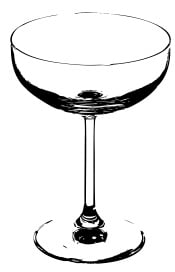At Donor By Design, we are guided by a series of axioms: core concepts that shape our work and have proven their worth over and over again. In this series, we’re digging into these axioms and clarify how they can help you achieve your development goals. Read Part 1 or Part 2.
For years, the big fundraising lie has been the donor pyramid. You know what I am talking about: the image of a pyramid that shows we need a large gift at the top, a few more at the next level and so on until you get to the base of the pyramid. Nonprofit leaders have shared this with their boards and donors, but, if you do regression analysis on campaigns, the infamous pyramid looks more like a donor pagoda or, as I like to call it, the donor champagne glass.
Your Top 20 and Next 30 gifts will represent 85% of your whole campaign! It doesn’t matter if your campaign is $1MM or $100MM – this is how it works. I find this both positive and encouraging. We really only have to focus on building relationships and raising interest with a small subset of donors to have a big impact on campaign success. A recent New York Time’s article took it even farther saying:
“In recent years, fund-raisers and school heads say, more revenue is coming from a smaller group of parents and what used to be the “80/20 rule” — 20 percent of the parents give 80 percent of the money — has become the 90/10 rule, or even the 95/5 rule.”
A few thoughts and observations in light of the champagne glass-shape of campaigns:
- Do you know who your Top 20 prospects are for your fundraising efforts? What is your donor engagement plan for each of these prospects?
- How well do you know your Top 20 prospects? Do you really know them? What are their interests and drivers?
- Are you staffing your development efforts toward the pyramid or the champagne glass?

Draw a champagne glass.
Bracket the cup portion. Bracket the stem portion. Bracket the base.
To the right of each bracket, note your development department spending for each segment of the glass (salaries, benefits, materials, travel … everything).
Where are you spending your development budget? Are you appropriately resourcing your department? Make sure the majority of departmental resources are going towards the efforts that will have the greatest impact.
As you shift your focus to the donors in the top of the champagne glass, don’t forget those in the stem and the base. While these donors may account for a smaller percentage of your campaign total, they are still showing their support for your cause by the sacrificial gifts they are making. Stewardship is critical at all levels of giving, and can raise a donor’s interest in your organization, even as their capacity to give increases over the years.

